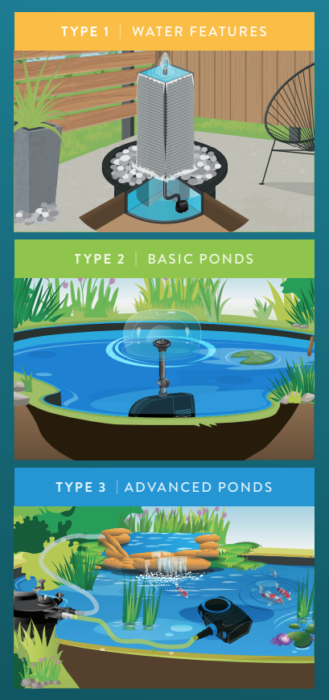
Every Aussie who’s building a backyard water feature dreams of a brilliant pond filled with healthy fish. However, achieving and maintaining this requires more than wishful thinking.
Keeping your pond sparkling and your fish thriving requires regular care and the right equipment.
At the heart of a healthy pond ecosystem is a high-quality fish pond pump. But with so many styles, sizes, functions and features available, how do you choose the right fish pond pump for your project?
In this article, we’re helping you filter through all the information and make the right decision.
Fish pond pump 101: What do they do?
A fish pond pump is a low-powered electrical device submerged under the surface of your pond.
It’s essentially a small machine that pulls water in from one area of the pond and pushes it out with force. This creates water circulation, which is vital for a healthy fish pond.
How fish pond pumps keep your water pristine
A properly sized and well-functioning fish pond pump plays a vital role in maintaining healthy water quality. Here’s how:
Circulation is key
A good pump keeps water moving, preventing stagnation. This circulation is crucial for distributing oxygen throughout the pond, which fish and other aquatic organisms need to breathe.
Filtration on tap
Fish pond pumps filter water as they circulate it, removing physical debris (like leaves and uneaten food) and biological waste (like fish excrement). This filtration process is essential for removing harmful toxins like ammonia and nitrite that can harm your fish.
Choosing the right pump for your pond
With so many pumps available, selecting the right one can seem daunting. Here are some key factors to consider:
Pond size
Knowing the size of your pond is crucial for choosing a pump with the right flow rate, which is the maximum volume of water that the pump can circulate in an hour.
Use our free pond volume calculator tool to estimate the size of your water feature, and browse our extensive range of fish pond pumps to find one with the right flow rate.
If you’re unsure, it’s better to choose a pump with slightly more capacity than you need. A pump too small won’t have the power to circulate water, while a significantly oversized pump can be inefficient and create excessive current.
Need help choosing the right equipment for your application? Aquapro’s innovative selection process tool is designed to simplify your search for the ideal fish pond pump and water quality solutions.
Tailored to cater to various needs, our tool categorises products into three distinct types, each addressing specific requirements:
- Type 1 products, labeled orange: encompass pumps ideal for desktop, patio, and garden water features. For basic pond setups,
- Type 2 products, labeled green: are your go-to choice, perfect for preformed garden ponds with minimal or no fish. Meanwhile,
- Type 3 products, labeled blue: are tailored for advanced ponds boasting waterfalls, lush aquatic plants, and a thriving fish population.

With our color-coded system, navigating through the selection process becomes effortless, ensuring you create a healthy and vibrant aquatic environment for your beloved fish companions.
Filtration needs
There are two main types of fish pond pump filters. Understanding the differences will help you choose the right filter or all-in-one system.
Sponge filters, like our AQUAPRO 2000 All-in-One Pump and Filter, are often used in small ponds. A pump pulls water through the sponge, trapping large debris and waste particles. Sponge filters are relatively low-maintenance but may not be sufficient for ponds with a heavy fish load.
Pressure filters like our AP5000UV Pressure Filter UV Combo are more powerful and require higher flow rates. They come in sealed canisters and filter water using materials like bio media, gravel, sponges and UV light. Pressure filters require more cleaning than sponge filters, but they offer better biological filtration, especially in larger ponds or those with many fish.
Combined or connected?
Depending on the environment, your fish pond pump may feature a built-in filter or work together with a separate high-capacity filter unit.
All-in-one pump and filter units simplify maintenance in small to medium ponds, such as the AQUAPRO Intermediate Fish Pond Kit with a 2,000-litre all-in-one filter pump.
For larger or more populated ponds with more serious filtration needs, we recommend separate (connected) pump and filter units for reliable water quality. Hence why the AQUAPRO Advanced Fish Pond Kit comes with a filtration pump and pressure filter.
Water features
If your pond incorporates a water feature, ensure your pump has the power to achieve the desired effect.
This is often possible with our all-in-one fish pond pumps in small and medium ponds. The included fountain kit has a two-metre head height, meaning it can create an impressive display out of the box.
For larger ponds, you may consider a second pump dedicated to the water feature if your primary pump is busy with the filter.
To help you understand the balance between pump capacity, filtration and water features, there is a chart in the product description for each AQUAPRO fish pond pump. It looks like this:

This chart, for our AP3100DW Filtration Pump, shows the maximum flow rate at various head heights – and compared to its big brother, the AP6100DW – so you know exactly what your fish pond pump is capable of.
Find your ideal fish pond pump kit at AQUAPRO Online
We’re committed to providing high-quality products to create and maintain the perfect home for your aquatic friends.
Check out the range of fish pond pumps and all-in-one kits on our website, or visit your local Bunnings to pick up a pump you can rely on.
Keep Plants Trimmed and Pond Tidy
As autumn progresses, pond plants can begin to die back. Keeping these plants trimmed is crucial to prevent any dead parts decomposing in the water, leading to water quality problems like increased algae growth. For this reason, it’s always a good idea to regularly inspect garden ponds for plant debris and remove any dead material quickly. Additionally, consider thinning out live plants if they are overgrown. This helps maintain good water flow throughout the pond, reducing the likelihood of stagnant spots that can harbour pests or diseases.
Move Waterlilies If Necessary
Waterlilies are a stunning addition to any pond, but they require specific care as the season changes. In cooler areas, it’s wise to move waterlilies to deeper parts of the pond where the water remains warmer. This prevents the rhizomes from dying. In milder climates, simply ensure that these plants are still receiving enough sunlight and are not being overshadowed by deciduous trees that are now dropping their leaves.
Do Not Allow Leaves to Accumulate
In autumn, one of the biggest challenges is preventing leaves from accumulating in a pond. Falling leaves can quickly decompose in still water, releasing carbon dioxide, methane and nitrogen from the detritus that can harm aquatic life and cloud your pond’s water. By using a pond net to catch leaves before they sink, you can effectively manage this issue. Simply secure a net just above the water’s surface and regularly clear the collected leaves. Additionally, ensure that the area around the pond is kept tidy, with nearby trees and shrubs pruned to minimise the amount of foliage falling into the water.
Avoid Overfeeding the Fish
Overfeeding any fish in the pond is a common mistake that can lead to significant problems, especially during autumn when the water temperature begins to drop. Fish metabolism slows down in cooler water, which means they require less to eat. Feeding them too much can result in uneaten food decomposing in the pond, which also muddies the water, increases nutrient levels and again promotes algae growth. To prevent this, feed your fish only as much as they can consume in a few minutes and switch to a lower-protein food designed for cooler temperatures.
Perform Regular Checkups
Regular checkups are vital to keeping your pond clear and functioning well throughout the autumn months. These should include inspecting all mechanical systems, such as pumps, filters and pond accessories, to ensure they are clean and in good working order. Clear any blockages in the filters and check the pumps to ensure they are providing adequate water circulation to prevent stagnation.
Also, test the water quality regularly. Parameters like pH, oxygen and nitratecompound content levels are crucial for the health of your pond. Simple, easy-to-use, test kits are available, providing valuable information that can help you address any issues before they become significant problems.
Invest in the Right Tools
Keeping garden ponds clear and healthy during autumn doesn’t have to be complicated, especially when you’re equipped with the right pond accessories.
Let’s explore some of the key tools that can help you achieve a clear and thriving pond:
Pond Net
A pond net is an indispensable tool for any pond owner, particularly in autumn when leaves and other debris can quickly accumulate. A good quality net helps you to remove floating debris before it sinks and decomposes. Additionally, using a pond net to cover your pond can prevent leaves from entering in the first place, making this a preventative, as well as a reactive, tool.
Pond Pump
A pond pump, in combination with the ’Little Pond Sucker,’ is crucial for maintaining water circulation and oxygenation in your pond. Proper circulation helps prevent the water from becoming stagnant, which is vital for both the health of aquatic life and the clarity of the water. It helps distribute oxygen throughout the pond which is important for pond life and fish. It also facilitates the breakdown of waste products, reducing the buildup of harmful substances.
Bionatural Sludge Away
Autumn is a good time to start using products like Bionatural Sludge Away, which helps break down the sludge that accumulates at the bottom of the pond. This sludge is often made up of fish waste, plant debris and other organic materials that can lead to algal growth and poor water quality. Regular use of a natural sludge remover can keep your pond bottom clean without harming the pond’s natural flora and fauna.
Water Treatments and Conditioners
Water treatments and conditioners are essential to adjust and maintain the water chemistry in your pond, particularly as temperatures change with the seasons. These products can help stabilise pH levels, reduce harmful nitrate and ammonia concentrations and add essential minerals that benefit fish and plants. Regular use of a water conditioner can also help make tap water safe for pond use by neutralising chlorine and heavy metals, ensuring that your pond environment remains healthy and supportive for all its inhabitants.
Keeping Your Pond Perfect This Autumn
That’s all there is to it! Following the guidelines outlined above will keep your garden pond clear and healthy throughout autumn. Remember, a little effort goes a long way in maintaining the beauty and balance of your pond for it to remain a standout feature in your garden this autumn.
Consult our online guides for ideas and to browse our extensive selection of pond accessories or contact us at AquaPro for more expert advice. Discover all the essentials you need to keep your garden pond thriving throughout the year.
